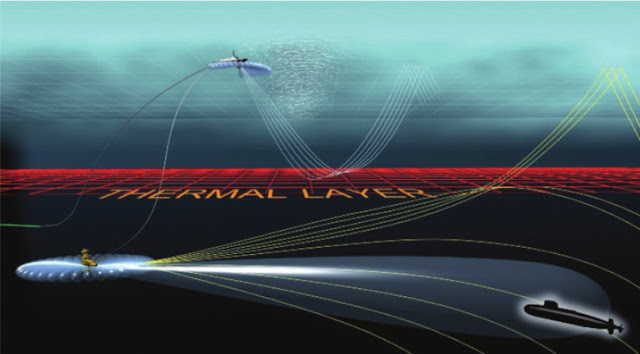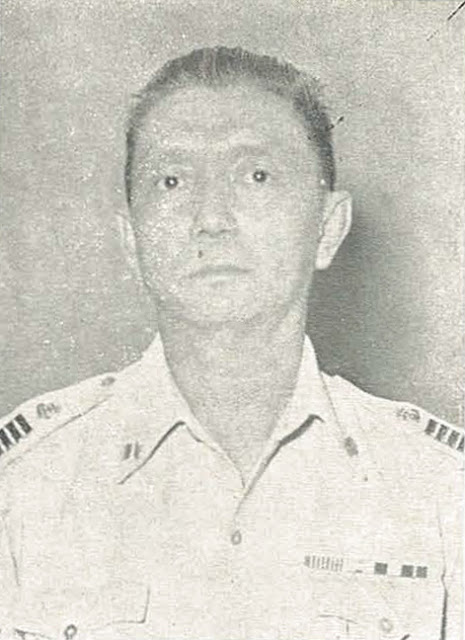Second Time Lucky?
In the 1990s, Malaysia perceived the need to replace its ageing Vosper 103ft Type patrol crafts ( PC ), tiny boats with a length of 31m displacing just 96 tons that had been in service since the 1960s. Known as the New Generation Patrol Vessel ( NGPV ) Project, the initial specifications called for a Offshore Patrol Vessel ( OPV ) design which displaced 1300 tons with a length of 80m. However, the winning bid, based on the Blohm + Voss MEKO 100 design, ended up displacing 1850 tons with a length of 91m, a size resembling a corvette rather than an OPV. The NGPV project was plagued by delays caused by quality control issues and cost overruns, and when it was finally concluded in 2010, yielded only six ships of the guns only KD Kedah-class out of the originally intended twenty seven. Given that situation, one may logically presume that the Royal Malaysian Navy ( RMN ) would be fairly desperate in need for new surface combatants to boost the strength of its Fleet.
Indeed in early 2011, Malaysia initiated the Second Generation Patrol Vessel ( SGPV ) Project which aims to provide the RMN with six stealth frigates by the end of the decade, a timely procurement, since by then, not counting the NGPVs, even the newest Lekiu-class frigate would have been in service for more than twenty years. Further more, with the increasingly belligerent stance of China in the South China Sea, many of the surrounding littoral states are locked in an urgent arms race to boost their naval capabilities. Malaysia cannot really afford another fiasco like the NGPV project, or can they?
 |
| The SGPV is based on the Gowind 2500 stealth ship. Image : DCNS |
 |
| CGI : Gowind 2500 with hangar and helicopter in view. Image : DCNS |
Second Generation Patrol Vessel - Littoral Combat Ship
Malaysia's next generation frigate programme is known as the Second Generation Patrol Vessel - Littoral Combat Ship ( SGPV-LCS ) Project. The name is somewhat misleading as the ships involved are essentially multi-mission frigates, major ocean-going surface combatants, rather than patrol vessels which generally implies a much smaller and lightly armed warship for close shore duties. The inclusion of the words Littoral Combat Ship may also cause unnecessary confusion with the US Navy's pre-existing Freedom-class and Independence-class Littoral Combat Ships.
The project was announced in early 2011 and originally involved six frigate type warships with stealth features displacing about 2700 tons. The budget for this project was MYR6billion, then worth about US$1.9billion. There were several contenders, including Germany's ThyssenKrupp Marine System with their subsidiary Blohm+Voss' MEKO 200 design, Dutch Damen Schelde Naval Shipbuilding with its Sigma-class 10514 and the French DCNS with the Gowind-class. TKMS being the parent company of Blohm+Voss was of course no stranger to Malaysia as it was closely involved with the NGPV project and was also the supplier of the older Kasturi-class light frigates while Damen had recently been successful in selling Indonesia its scalable Sigma 9113 corvettes and Sigma 10514 frigates. DCNS on the other hand supplied Singapore with its La Fayette-class derived Formidable-class stealth frigates and sold Malaysia their Scorpenes and Agosta-B submarines.
By end 2011, it emerged that the French Gowind based design had been chosen and a contract worth MYR9billion ( then USD2.8billion ) had been awarded to Boustead Naval Shipyard Sdn Bhd which will team up with DCNS to build the vessels locally at their Lumut yard. Boustead Naval Shipyard is one of many companies under the umbrella of Boustead Heavy Industries Corporation Berhad which is itself part of a bigger, publicly listed, government linked industrial conglomerate known as Boustead Holdings Berhad. So just what is a Gowind-class vessel?
DCNS's Gowind Family
The Gowind is DCNS's solution to littoral warfare. It is not a single vessel but a collection of warships types that spans several classes from entry level OPV types to higher end corvettes and light frigates. Just like the MEKOs and Sigmas, the Gowind's modular design makes it highly scalable. The vessels are all shaped to have a reduced radar cross-section signature and have additional stealth features as an integral part of their design, such as a single integrated mast where all the sensors are mounted. That replaced several sensor masts in older designs which tends to contribute to unnecessary clutter and increased reflection of radar waves. The main guns can be encased in stealth cupolas. The propulsion system is that of combined diesel and diesel ( CODAD ) configuration with no funnel stack to emit infra-red radiation. Instead the engine exhaust is dissipated as waterjets which also served to enhance the maneuverability of the ships especially in shallow waters.
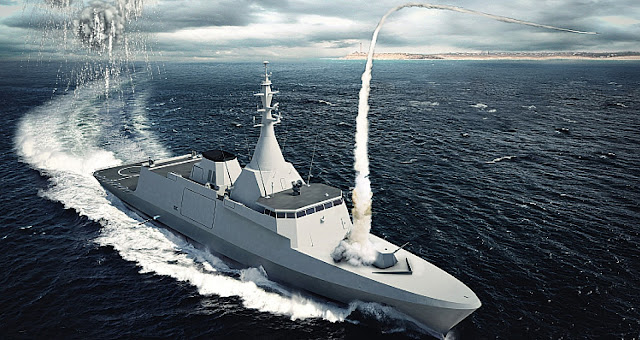 |
| Smoke and fumes from a VL Mica launch obscures the 16 cell vertical launch system behind the main gun while chaff has been dispensed aft of the Gowind 2500. Image : DCNS |
 |
| The Gowind 1000 launches an anti-ship missile. Note the array of 8 vertical launch cells on a raised portion behind the main gun. Image : DCNS |
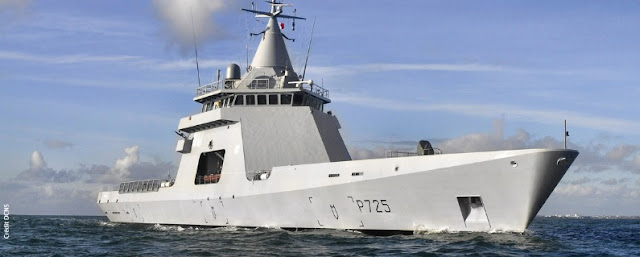 |
| The Gowind OPV now known as the OPV90 by Kership serving in the French Navy as the L'Adroit. Image : Kership |
 |
| The FS L'Adroit of the Marine Nationale at the Singapore Navy Open House in 2013. Photo via Wikicommons. |
Although DCNS's website list only two Gowind variants, the Gowind 1000, a 1500 ton lightly armed version for less demanding missions and the much bigger Gowind 2500, a 2500 ton multi-mission corvette type with significant anti-submarine capabilities, there are more variants including an OPV type now renamed the OPV90 that had been reassigned to Kership, a DCNS subsidiary. In fact DCNS even built one, the OPV L'Adroit, and loaned it to the French Navy for evaluations for a period of three years, seemingly free of charge. You can watch DCNS' video on the L'Adroit here.
All Gowind variants come complete with a helideck for helicopter and UAV operations while the larger vessels also feature a helicopter hangar. In DCNS's original configuration, the Gowind corvettes are armed with a 76mm main gun, two 20mm cannons, vertical launched MICA surface to air missiles and MM-40 Block 3 Exocet anti-ship missiles. In addition, the Gowind 2500 has two triple torpedo launchers as part of its ASW arsenal, though they are listed as only an option in the Gowind 1000.
The Gowind vessels are capable of operating unmanned systems, including unmanned aerial vehicles ( UAV ), unmanned underwater vehicles ( UUV ) and unmanned surface vehicles ( USV ).
 |
| Gowind 2500 Specifications and Characteristics. Source : DCNS |
As of today, DCNS had already secured orders for 10 Gowind ships. Malaysia's 6 vessel contract was the first commercial success ( paid order ) for the type while the Egyptian Navy became the second customer with 4 vessels on order. All were presumably variants based on the design of the larger and more capable Gowind 2500 ( Malaysia ) or the Gowind 2500 base model itself ( Egypt ).
Malaysia's Gowind SGPV-LCS
Malaysia's finalized SGPV design is a frigate sized derivative of the Gowind 2500 corvette displacing 3100 tons, an increase from the initial proposed displacement of 2700 tons. With that there has also been a 50% increase in the acquisition cost from MYR6billion to MYR9billion. The price includes intellectual property rights and technology transfer, which could mean Malaysia owns the rights to the modified Gowind design and might be able to export it to interested third parties in the future. That is of course provided Boustead Naval Shipyard is able to build them according to specifications in the first place.
 |
| Malaysia's Gowind-class Second Generation Patrol Vessel- Littoral Combat Ship. Source : Boustead Naval Shipyard |
These are some of the known specifications including sensors and armaments for the Gowind SGPV :
Length : 111 meters
Breath : 16 meters
Draught : 3.85 meters
Displacement : 3100 tons
Propulsion : Combined Diesel and Diesel ( CODAD )
Engine : 4 x MTU Diesel
Maximum Speed : 28 knots
Range : 5000 nautical miles at 15 knots
Endurance : 21 days
Complement : Up to 138
Combat System : DCNS SETIS
Search Radar : Thales Nederland SMART-S Mk 2 3D Multi-beam Radar
Fire Control Radar : Rheinmetall TMX/EO Mk II Fire Control Radar
Rheinmetall TMEO Mk II Electro-Optical Tracking System
ESM : Thales VIGILE 100 Electronic Support Measures System
Sonar : Thales CAPTAS-2 Variable Depth Sonar
Hull Mounted Sonar ? Thales Bluewatcher
Communications : Thales TUUM-6 underwater communications equipment
Thales TSB 3520 ATC / IFF Combined Interrogator Transponder
Decoy : Wallop/Esterline Super Barricade Decoy System
Main Gun : 1 x BAE Systems 57mm Mk3 Naval Gun in Stealth Cupola
Cannons : 2 x MSI Seahawk 30mm cannons
SAM : MBDA VL Mica in 16 Sylver ?A35 launchers
SSM : 2 x 4 Kongsberg Naval Strike Missile
Torpedo : 2 x J+S ( Now SEA ) 324mm Triple Torpedo Launcher
Helicopter : EC725 Caracal / AugustaWestland Super Lynx 300 / Eurocopter AS350 Fennac
Constructing the SGPV
Unlike Egypt's 4 corvette deal with DCNS where the first-in-class would be constructed in France and the remaining three in Alexandria, Egypt, the Malaysians elected to have the entire batch of six frigates constructed locally at their Boustead Naval Shipbuilding ( BNS ) shipyard at Lumut, Perak. This was a bold decision, given that at that point of time the Lumut facilities were not quite built for the task of constructing the stealth frigates. A major upgrade had to be carried out with the help of DCNS before construction of the vessels could begin.
It was subsequently revealed that although the USD2.8billion contract was awarded to BNS / DCNS in 2011, it only went into effect on 14th July 2014, after the completion of a massive infrastructure upgrade at the Lumut shipyard - ship lifts, block assembly halls, panel assembly halls and keel laying lines. The Malaysians even planned to have three ships in parallel construction at the yard. The Gowind contracts with Malaysia and Egypt was only confirmed by DCNS later that year.
 |
| Aerial view of the Boustead Naval Shipbuilding Lumut Shipyard at the mouth of Sungai Manjung. Source : Boustead |
 |
| BNS Lumut yard now seems to have upgraded shiplifts. Source : Boustead Naval Shipbuilding |
 |
| Another view of BNS Lumut. Source : Boustead Naval Shipbuilding |
Not only will the ships be constructed in Malaysia, even the combat system will be assembled and tested at the not too distant Cyberjaya town, part of the ex-ex-Prime Minister Mahathir's grandiose Multimedia Corridor and Malaysia's Silicon Valley wannabe. Potential systems suppliers and integrators are in a way forced to perform as much work on the ships as possible locally in Malaysia. In fact any foreign company who wish to participant in the SGPV project will probably have to agree to set up some joint venture with well connected locals or local companies, a regional headquarters here, a training facility there, some maintenance and servicing company to cater for subsequent repairs and upgrades, and so on and so forth. You get the idea.
To cite specific examples, J+S Ltd, a British company selected to supply the torpedo launch system for the SGPV, had opened an office in the Malaysian capital Kuala Lumpur to serve the ASEAN region. They also announced that they would be sourcing some products and services locally. Thales, the supplier of the Smart-Ass Mk2 naval surveillance radars will be building the first two systems in the Netherlands but the remaining four would be assembled and tested in Malaysia by a local company Contraves Advanced Devices Sdn Bhd which itself is jointly owned by who else but Boustead Heavy Industries Corporation and Rheinmetall Defence.
All these came as no surprise since Malaysia is a nation obsessed with offsets, technology transfers and industrial joint ventures, even to the extend of dabbling with bartering every once in a blue moon. For example, the €1.035billion scorpene submarine deal with DCN in 2002 obligated France to in return buy €230million worth of Malaysian palm oil, €92million of other commodities and invest €138million for training and technology transfers to local Malaysian firms. There was allegedly also a spin off deal to increase the landing rights for Malaysia Airlines at the Charles de Gaulle Airport in Paris. Then there was the Sukhoi Su-30MKM deal that came with the condition that Russia help train and send a Malaysian astronaut to the International Space Station, which they eventually did as promised, and that happened in 2007. Even earlier, Yeltsin was partially paid in Malaysian palm oil for the MiG-29 deal ....
Construction of the yet to be named lead vessel started in Jun 2015 and would be completed in early 2019. The subsequent five ships would be completed at ten months interval thereafter, which means the last ship would be completed sometime in 2023. The image from Boustead Naval Yard seem to suggest the lead ship will be having the pennant number F177, continuing serially after the six Kedah-class NGPV which have pennant numbers from F171 to F176.
 |
| Keel laying signals the official start of the ship construction. This is probably hull number 2. Image via RMN Tweet. |
Strengths and Weaknesses
Malaysia's Gowind-class frigates are great warships with many advanced features and capabilities. Being brand new they also include the latest design trends and incorporate the latest technology in maritime security and naval warfare. At 3100 tons fully loaded, these are fairly large in size and that translates to better sea keeping, higher endurance and a higher level of comfort for the serving ship crew. As a class they should be able to execute their mission of protecting Malaysia's vast maritime interests well and form a credible deterrence against any potential aggression by regional countries. Unfortunately there are certain omissions that could have an adverse impact on the ship's combat capabilities.
A main gun with a bigger caliber, like the 76mm ( 3 inch ) Oto Melara Super Rapid would be a better choice. Bigger guns have longer reach and make for better shore bombardment should that requirement ever arise, like when some rag tag militia force from some self proclaimed Philippine sultanate come occupying your outlaying islands. Even RMN's newest Kedah-class corvettes are armed with 76mm main guns. Stealth cupola or not 57mm just seem too small for a full fledged frigate. They are more suited for smaller surface combatants like corvettes and FAC.
 |
| The BAE Systems / Bofors 57mm Mk3 in stealth cupola on the Swedish Visby-class corvette. Photo : Wikipaedia |
A pair of MSI Defence Systems Seahawk remotely controlled 30mm cannons on a gyro-stabilized, electrically operated mount with an electro-optical director is great for force protection against asymmetric threats like hordes of fast boats but it cannot double as a close-in weapon system ( CIWS ) for last line of defence against sea skimming anti-ship missiles and precision guided munitions ( PGM ). Without a dedicated gun-based CIWS, the SGPV in effect relies on the VL-MICA as a missile-based CIWS. No doubt the VL MICA does have anti-missile capabilities, but would you put all your eggs in one basket?
The choice of short ranged VL Mica for the frigates' air defence is also not ideal. Although the VL Mica is an extremely capable and proven design which combines compactness and light weight with a short reaction time, high rate of fire and multi-target capabilities ( including missiles and PGM ), its Achilles Heel is really its relatively short range of up to 20km. Its maneuverability rapidly falls from 50G at 7km to 30G at 12km as kinetic energy is bled off with increasing distance from the point of launch. It is good for point defence but would not be so suitable for area defence. So the VL Mica might be perfect for a smaller vessel like the NGPV but I would expect a frigate to be able to provide task force-wide area defence. Assuming that the Gowind frigate has the shortest Sylver A35 chosen, having a longer vertical launch system ( VLS ) like the A43 or A50 which can accommodate longer ranged surface-to-air missiles like the MBDA Aster 15 or Aster 30 respectively would have been a better choice.
Ditching the MM40 Block III Exocet in favour of the Kongsberg Naval Strike Missile ( NSM ) could prove to be a good move. Both have anti-ship, littoral and coastal attack capabilities, both have effective range in excess of 100 nautical miles but the NSM is a much more contemporary design whereas the Exocet could trace its lineage to the 1970s. It is true that compared to even the MM40 Block II, the Block III is like a radically new missile, but the RMN already has in its service the SM39 and the MM40 Block II. So it might not be a bad idea to diversify the SSM inventory with the NSM so as not to be to overly reliant on one supplier. The NSM would give the RMN's surface fleet enhanced land attack capabilities in addition to its anti-ship role.
 |
| A model of the Kongsberg Naval Strike Missile on display. Photo : Wikipaedia |
 |
| The Kongsberg Naval Strike Missile successfully being test fired on the USN Littoral Combat Ship LCS4 USS Coronado in July 2014. Photo : USN |
The selected surveillance radar, the Thales SMART-S Mk2, is a capable radar system that has already been installed on corvettes and frigates of many navies, including Germany's Brandenburg-class frigates and as a future upgrade for New Zealand's ANZAC-class frigate. The acronym stands for Signaal Multibeam Acquisition Radar for Tracking, S-Band. It is a medium to long range air and surface multibeam passive electronically scanned array ( PESA ) 3D radar designed by Thales Nederland ( formally Thomson-CSF Signaal ) and as the name implies, operates in the S-Band ( with frequencies between 2 - 4 GHz, also known as E/F-Band in NATO nomenclature ). Its maximum instrumented range is 250km against air targets and 80km against surface targets. It can automatically detect and track up to a total of 750 air and surface targets simultaneously. Easy to use with only two operational mode and minimal operation system settings, the SMART-S Mk2 also features high operational availability through the use of solid state technology and ease of maintenance with line-replaceable-units that are easy to exchange when defective.
The Thales CAPTAS-2 / UMS 4229 long range low frequency active and passive variable depth sonar ( VDS ) is a compact and versatile detection system for medium ASW platforms 1500 tons and above. CAPTAS is the acronym for Combined Active and Passive Towed Array Sonar and it comes in three versions for vessels of different sizes, CAPTAS-1, -2 and -4. A VDS essentially enables the ASW unit to transmit and receive at the right depth to maximise the detection of very quiet modern diesel-electric submarines such as the Russian Kilo-class or Chinese Type 39A Yuen-class SSK. The CAPTAS-2 is rugged, operational up to sea state 6, and has a maximum operational depth of 250m. The detection performance is listed by Thales as beyond the first oceanic convergence zone which means in excess of 20 to 30 nautical miles. It has embedded torpedo defence capability and multi-platform operation capability with two frigates in the same area. In times of emergency, such as torpedo avoidance, the towed array can withstand towing at 30 knots. Deployment and retrieving of the towed array can be completed in 20 minutes. The CAPTAS family of VDS has already ben installed or selected for more than 40 ships including the FREMM frigates of the French, Italian and Moroccan Navies. You can watch a video of the smaller CAPTAS-1 and BlueWatcher hull-mounted sonar in action here.
 |
| The Thales CAPTAS-2 towed body. Image : Thales |
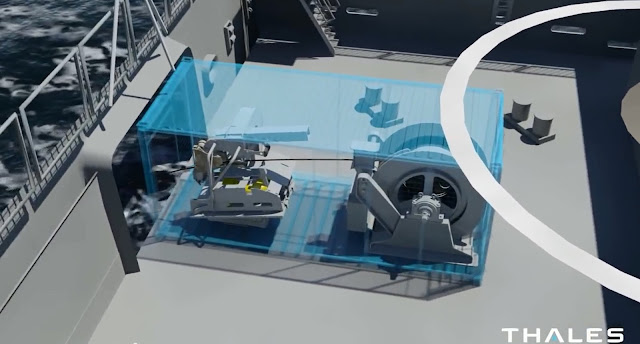 |
| The CAPTAS-1 with its winch can be installed in a containerized system below the helideck. Image : Thales |
 |
| The transmitting Towed Body attached to the winch cable. Image : Thales |
 |
| CAPTAS-1 VDS Single Tow : The Body ( seen transmitting ) tows the Receive Array. Image : Thales |
The electronic support measures ( ESM ) suite chosen was the Thales Vigile 100 system. The vigile family is Thales' 4th generation ESM system tailored for naval applications for both surface and sub-surface units. According to the manufacturer, it provides wide band ( C to J Bands ), high sensitivity receptions and pulse analysis with the ability to detect low probability of intercept (LPI) or invisible hostile radars using ultra sensitive search mode. It also supports electronic intelligence (ELINT), precise de-interleaving, and specific emitter identification/platform identification using ESM tasked mode measuring signals frequency, phase and amplitude.
Although the Gowind-class incorporates the latest technology and is purpose-designed to be able to operate unmanned systems, Malaysia seem to have decided not to equip its new frigates with any unmanned aerial vehicles as originally planned, like the VTOL Airbus Tanan. This is puzzling as UAVs can be valuable assets to augment existing capabilities and are a force multiplier for any platform, big or small. Then again, nothing that Malaysia does make much sense to us most of the time. This omission may cost the RMN in the future.
.
 |
| The Airbus Tanan VTOL UAS with Gowind 2500. Image : Thales |
 |
| Airbus Tanan UAS and frigate with variable depth sonar. Image : Airbus |
Trail Blazing with the Gowind Stealth Frigate
Malaysia's decision to go with the wind and select the Gowind 2500-class as a basis for its SGPV-LCS future frigate programme could be viewed as a bold trail blazing move. This is because they are the type's first real, paying customer, internationally or otherwise. Even the French Navy does not own any. The OPV FS L'Adroit is not counted as it is on loan to the navy for evaluation and perhaps publicity, and it was for free. So actually till today nobody has built a frigate sized Gowind before. New platforms usually have their fair share of teething problems and the SGPV will no doubt face similar issues. More so if it were to be constructed outside France. The decision to construct everything in Malaysia could represent a good opportunity for local companies to benefit from technology transfers and generate much needed jobs for Malaysian workers. If not implemented properly, it might just lead to the same delays and cost overruns that plague the previous NGPV project. However, with an experienced stealth ship builder like DCNS providing technical expertise and support, such problems might hopefully be minimized.
Questions remain as to why the cost of the six ships was allowed to balloon from the initial budgeted MYR6billion to MYR9billion. It is puzzling especially considering that the ships' combat systems, though capable, are not all entirely top of the line and many of the systems initially desired by the RMN were eventually scaled down or opted out, like the UAV. Also, why has the tonnage to increase from the originally planned 2700 tons to the finalized 3100 tons? Either RMN doesn't know what it needs or its decision is too easily swayed by the vendor's marketing antics, or both. Could the mere increase in tonnage account for such a vast price rise or is Malaysia also paying so much more because it wanted to retain the intellectual property rights to the frigate's designs? If so is it a wise decision given the current poor economical and political situation in Malaysia? The final bill for the six ships will likely be much higher than MYR9billion due to currency exchange fluctuations in favour of the Euro / US Dollar as the Ringgit had weaken considerably in the past five years since the project had began and it is unlikely to strengthen in the near future. In this scandal prone country, could it be another bribery scam in the making, perhaps even with another murder or two thrown in as well?
Looking at the dilapidated state of the RMN today, with only six semi-equipped OPVs, two barely there post-SLEP corvettes and two ageing frigates forming the core of the surface combatants, the induction of these Gowind frigates into the Fleet will undoubtedly be keenly anticipated by the Malaysians. When that day arrives, the Malaysian Navy can at least claim parity with regional navies like the Indonesian Navy and the Singapore Navy and declare that they also own and operate stealth vessels, in the process Winning back some lost prestige.
